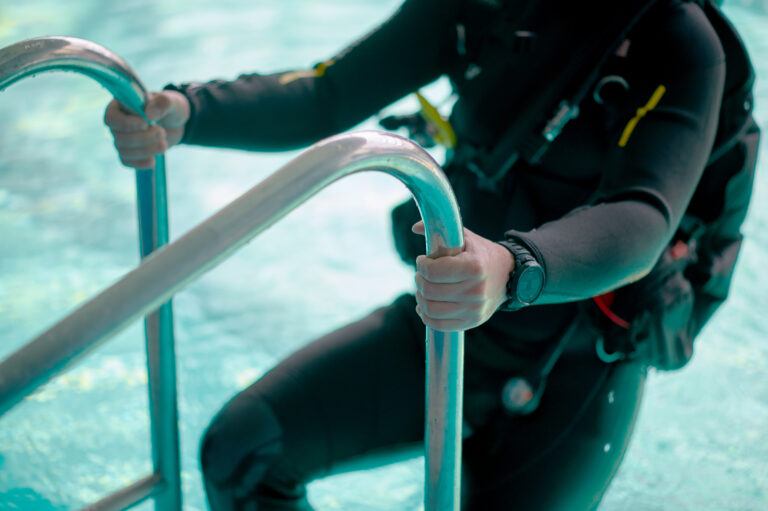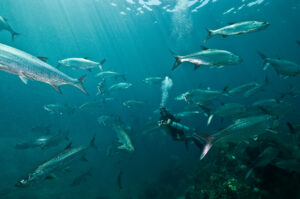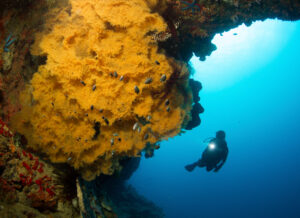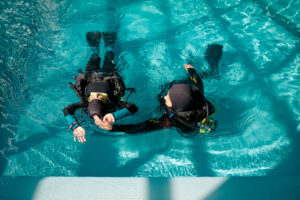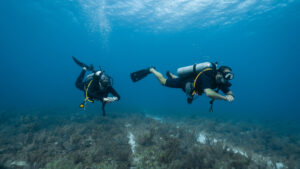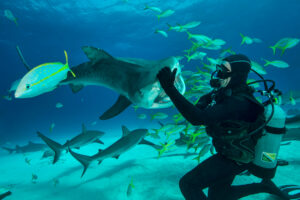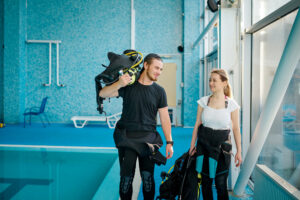What is Exposure Protection when Scuba Diving, Freediving, or Snorkeling?
Exposure protection is an essential aspect of scuba diving, freediving, and sometimes snorkeling. Exposure protection ensures the safety and comfort of divers while they explore the underwater world. Exposure protection involves the use of specialized clothing or costumes designed to shield the diver from various elements, including cold water temperatures, abrasions, and harmful marine life. There are various types of exposure protection suits available, ranging from thin wetsuits to heavy dry suits, each offering a different level of protection and thermal insulation. This entry will discuss the various types of exposure protection suits, their materials, functionality, and proper care and maintenance.
Wetsuits
Wetsuits are the most common form of exposure protection in recreational scuba diving. Made from neoprene, a synthetic rubber material, wetsuits work by trapping a thin layer of water between the suit and the diver’s body. The body’s natural heat warms the trapped water, providing insulation against the surrounding cold water. Wetsuits come in various thicknesses, generally ranging from 2mm to 7mm, with thicker suits offering greater insulation.
Shorties
Shorties are wetsuits that cover only the torso, upper arms, and thighs. They are ideal for diving in warm water and offer limited thermal protection.
Full suits
Full wetsuits cover the entire body, including the arms and legs. They offer increased thermal protection and are suitable for diving in cooler water temperatures.
Semi-dry suits
Semi-dry suits are similar to full wetsuits but feature tight seals at the neck, wrists, and ankles to minimize water exchange. This design further enhances the suit’s insulating properties, making it suitable for colder water temperatures.
Drysuits
Drysuits are designed for diving in very cold water or for extended periods. Unlike wetsuits, drysuits prevent water from entering the suit entirely, keeping the diver completely dry. Drysuits are made from various materials, including crushed neoprene, trilaminate, and vulcanized rubber. The insulating properties of a drysuit depend on the type of undergarment worn beneath it, which can be adjusted according to the water temperature and personal preferences.
Shell drysuits
Shell drysuits are made from lightweight, waterproof materials such as trilaminate or vulcanized rubber. They offer minimal inherent insulation but provide a durable, watertight barrier that can be paired with various undergarments for insulation.
Neoprene drysuits
Neoprene drysuits are made from crushed or compressed neoprene, which provides both insulation and a watertight seal. These suits offer greater inherent insulation than shell drysuits but may be less durable.
Dive Skins and Rash Guards
Dive skins and rash guards are lightweight, form-fitting garments made from materials such as Lycra or Spandex. They provide minimal thermal protection but are effective in protecting against sunburn, abrasions, and stings from marine life. Dive skins and rash guards can be worn alone for diving in warm water or underneath wetsuits or drysuits for added protection.
Accessories
In addition to the primary exposure protection suits, divers often use various accessories to enhance their overall protection and comfort. These accessories include:
Hoods
Neoprene hoods cover the head and neck, providing additional insulation and protection from cold water and abrasions.
Gloves
Diving gloves, made from neoprene or other materials, protect the hands from cold water, abrasions, and marine life while maintaining dexterity.
Boots
Dive boots, made from neoprene or other materials, protect the feet from cold water, abrasions , and sharp objects while providing support and grip when traversing rocky or slippery surfaces.
Drysuit seals
Latex or silicone seals are used at the neck, wrists, and ankles of drysuits to ensure a watertight seal. Over time, these seals can wear out and need to be replaced to maintain the suit’s integrity.
Choosing the Right Exposure Protection
Selecting the appropriate exposure protection for a dive depends on various factors, including water temperature, dive duration, and personal preferences. As a general rule, divers should consider the following guidelines when choosing exposure protection:
Water temperature
The colder the water, the greater the insulation required. Wetsuits of varying thicknesses are suitable for warmer to moderately cold water, while drysuits are necessary for very cold water or long dives in cooler temperatures.
Dive duration
Longer dives, particularly in colder water, require increased thermal protection to prevent hypothermia and other cold-related issues.
Personal preferences
Each diver’s tolerance for cold and preferences for flexibility, buoyancy, and ease of donning and doffing will influence their choice of exposure protection.
Proper Care and Maintenance
To prolong the life and maintain the performance of exposure protection suits, proper care and maintenance are essential. The following tips can help ensure that suits remain in good condition:
Rinse thoroughly
After each dive, exposure protection suits should be rinsed with fresh water to remove salt, sand, and other debris. This helps prevent degradation of the suit’s materials and prolongs its life.
Dry properly
Exposure protection suits should be hung up to air dry, preferably inside-out, in a well-ventilated area away from direct sunlight. Direct sunlight can damage the suit’s materials and reduce its lifespan.
Store correctly
Store exposure protection suits flat or on a wide hanger to prevent creases or folds that can damage the material. Avoid storing suits in direct sunlight or in areas with extreme temperatures.
Inspect and repair
Regularly inspect suits for signs of wear and tear, such as small tears, broken seals, or damaged zippers. Promptly repair any damage to prevent further deterioration and maintain the suit’s performance.
Lubricate zippers
Periodically lubricate drysuit and wetsuit zippers with a suitable zipper lubricant to ensure smooth operation and prevent corrosion.
Exposure protection is a crucial aspect of scuba diving, as it enables divers to safely and comfortably explore underwater environments. By understanding the various types of exposure protection suits, their materials, and functionality, divers can make informed decisions about the best option for their specific needs. Additionally, proper care and maintenance of exposure protection suits will help ensure their longevity and continued performance, contributing to a safe and enjoyable diving experience.

